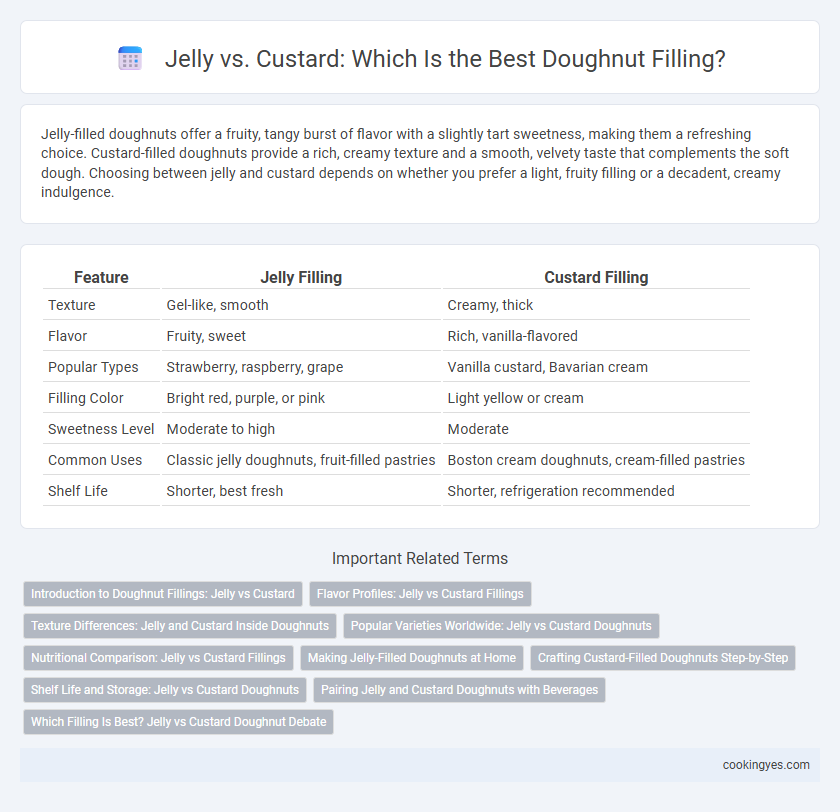Jelly-filled doughnuts offer a fruity, tangy burst of flavor with a slightly tart sweetness, making them a refreshing choice. Custard-filled doughnuts provide a rich, creamy texture and a smooth, velvety taste that complements the soft dough. Choosing between jelly and custard depends on whether you prefer a light, fruity filling or a decadent, creamy indulgence.
Table of Comparison
| Feature | Jelly Filling | Custard Filling |
|---|---|---|
| Texture | Gel-like, smooth | Creamy, thick |
| Flavor | Fruity, sweet | Rich, vanilla-flavored |
| Popular Types | Strawberry, raspberry, grape | Vanilla custard, Bavarian cream |
| Filling Color | Bright red, purple, or pink | Light yellow or cream |
| Sweetness Level | Moderate to high | Moderate |
| Common Uses | Classic jelly doughnuts, fruit-filled pastries | Boston cream doughnuts, cream-filled pastries |
| Shelf Life | Shorter, best fresh | Shorter, refrigeration recommended |
Introduction to Doughnut Fillings: Jelly vs Custard
Jelly and custard are popular doughnut fillings, each offering distinct textures and flavors that appeal to different preferences. Jelly fillings provide a fruity sweetness and a slightly tart contrast, utilizing ingredients like raspberry, strawberry, or grape preserves. Custard fillings deliver a rich, creamy texture with vanilla notes, made from egg yolks, milk, sugar, and vanilla extract, offering a smooth alternative to the bright, tangy profile of jelly.
Flavor Profiles: Jelly vs Custard Fillings
Jelly fillings offer a vibrant, fruity sweetness with a slightly tart edge, enhancing the doughnut's texture with a smooth, gel-like consistency. Custard fillings provide a rich, creamy flavor characterized by a velvety, buttery taste with hints of vanilla, complementing the doughnut's soft exterior. Choosing between jelly and custard depends on whether a light, refreshing burst of fruit or a dense, indulgent creaminess is preferred.
Texture Differences: Jelly and Custard Inside Doughnuts
Jelly-filled doughnuts offer a smooth, sticky texture that contrasts sharply with the fluffy, airy dough, creating a burst of fruity sweetness with each bite. Custard filling provides a creamy, velvety consistency that blends seamlessly with the doughnut's soft exterior, delivering a rich, indulgent mouthfeel. The distinct textural qualities of jelly and custard fillings influence the overall sensory experience, making jelly more vibrant and custard more luxurious.
Popular Varieties Worldwide: Jelly vs Custard Doughnuts
Jelly doughnuts, filled with fruit preserves such as raspberry or strawberry, are popular worldwide for their sweet and tangy flavor profile, especially in Europe and North America. Custard-filled doughnuts, rich in creamy vanilla or chocolate custard, appeal to those seeking a smooth, decadent filling and are favored in regions like Australia and parts of Asia. The choice between jelly and custard doughnuts often depends on regional taste preferences and the texture contrast desired in the doughnut experience.
Nutritional Comparison: Jelly vs Custard Fillings
Jelly fillings in doughnuts are typically lower in calories and fat but higher in sugars compared to custard fillings, which often contain more protein and fat due to their dairy content. Custard fillings provide essential nutrients like calcium and vitamin D, whereas jelly is primarily a source of simple carbohydrates without significant micronutrients. Choosing between jelly and custard fillings depends on dietary goals, with jelly favoring lower fat intake and custard offering more balanced macronutrients.
Making Jelly-Filled Doughnuts at Home
Making jelly-filled doughnuts at home involves filling soft, pillowy fried dough with fruit preserves like strawberry or raspberry jelly, which offers a lighter, tangy contrast to the dough's sweetness. Jelly fillings tend to be easier to insert using a piping bag or squeeze bottle, requiring less precision compared to custard, which is thicker and more temperature-sensitive during preparation. For best results, warm the jelly slightly to reduce thickness, and inject it carefully to prevent doughnuts from bursting during frying or baking.
Crafting Custard-Filled Doughnuts Step-by-Step
Crafting custard-filled doughnuts begins with preparing a rich, creamy custard using egg yolks, sugar, milk, and vanilla for a smooth texture. After frying the doughnut to golden perfection, a piping bag fitted with a long nozzle injects the custard into the center, ensuring an even distribution of the filling. This method contrasts with jelly-filled doughnuts, which often use a fruit preserve requiring less precision but delivering a tangier, more gelatinous filling experience.
Shelf Life and Storage: Jelly vs Custard Doughnuts
Jelly-filled doughnuts generally have a longer shelf life compared to custard-filled doughnuts due to their lower moisture content and acidity, which inhibits bacterial growth. Custard doughnuts require refrigeration and typically last 1-2 days before spoilage risks increase, while jelly doughnuts can be stored at room temperature for up to 2-3 days without significant quality loss. Proper airtight packaging enhances shelf stability for both, but temperature control is crucial for custard to prevent spoilage and maintain freshness.
Pairing Jelly and Custard Doughnuts with Beverages
Jelly doughnuts pair exceptionally well with fruity teas and fresh orange juice, as the tartness of the filling complements the bright, refreshing flavors. Custard-filled doughnuts are best matched with rich, creamy beverages like lattes or hot chocolate, enhancing the smooth, velvety texture of the custard. For an elevated experience, sparkling water with a hint of lemon balances sweetness from both types, cleansing the palate between bites.
Which Filling Is Best? Jelly vs Custard Doughnut Debate
Jelly and custard fillings each offer distinctive textures and flavors that appeal to different preferences in doughnut lovers. Jelly provides a fruity, slightly tart burst of sweetness with a clear, vibrant appearance, while custard delivers a rich, creamy, and smooth experience often enhanced by vanilla or other flavor infusions. The best filling depends largely on individual taste and the desired balance between fruity brightness and creamy indulgence in a doughnut.
Jelly vs Custard for Doughnut Filling Infographic

 cookingyes.com
cookingyes.com